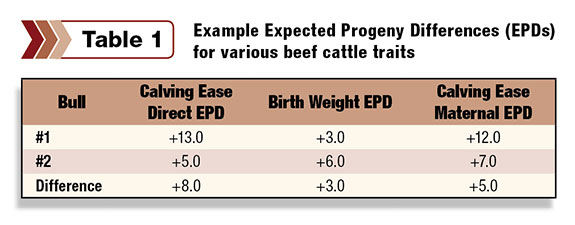Traditionally, since beef producers are paid for their animals on the basis of weight, or in some cases by the merit of animal carcasses, most EPDs reported in breed association sire summaries involve growth traits and carcass traits.
However, in today’s suite of EPDs, beef producers have at their disposal EPDs for growth traits, carcass traits, reproductive traits, maternal traits and index EPDs that combine a variety of traits for specific selection objectives.
Several studies have shown that approximately 2 percent to 4 percent of all beef calves born in the U.S. will be lost due to calving difficulty. Calving difficulties can occur with all beef females but is primarily a problem in first-calf heifers.
The economic losses due to calving difficulty are well documented. Some of the direct economic consequences of calving difficulty include injuries to calves and females and the loss of calves and females.
Additional economic losses result from things such as extended calving seasons, open females, decreased weaning weights and increased labor costs.
Many factors can play a role in causing calving difficulty including gestation length, calf gender, female pelvic area, calf shape, calving season, calf presentation, breed effects, nutrition, etc.
However, the single factor that contributes most to calving difficulty is calf birthweight. As calf birthweight increases, so does the level of calving difficulty and the percentage of heifers requiring calving assistance.
There is no question that calving difficulty is a great expense to cow-calf operations. As producers select bulls to use on first-calf heifers and small, younger cows, they should consider EPDs that assist in preventing and diminishing calving difficulties in beef cattle herds.
In 2007-2008, the USDA National Animal Health Monitoring System (NAHMS) conducted a study to gauge the informational and educational needs of U.S. beef cattle producers and document the use of various technologies and management practices on cow-calf operations.
The study included approximately 2,900 producers from 24 of the leading cow-calf states. Approximately 90 percent of all U.S. beef cows and approximately 80 percent of all U.S. beef operations were represented in the study.
One component of the study was to assess the need of beef producers to purchase bulls or semen to breed replacement heifers and the criteria used to select the bulls or semen.
Approximately 40 percent of cow-calf operations indicated a need to purchase bulls or semen for breeding replacement heifers. Those operations were asked to rank bull or semen selection factors by level of importance.
Calving ease EPD was ranked most important, second-most important and third-most important by 37 percent, 19 percent and 5 percent of operations, respectively.
Thirty-nine percent (39 percent) of operations did not consider calving ease EPDs as an important factor in selecting bulls or semen for breeding replacement heifers.
Another bull or semen selection factor noted in the study was birthweight EPDs. Birthweight EPDs were ranked most important, second-most important and third-most important by 12, 28 and 7 percent of operations, respectively.
Fifty-three percent of the operations did not consider birthweight EPDs as being important in selecting bulls or semen for breeding replacement heifers.
Calving ease as a selection criterion has been recommended for some time and has been successfully used by many producers.
However, considering the results from the NAHMS study, EPDs to reduce the incidence and impact of calving difficulty are not being used to their full potential.
Following is a description, discussion and example of how to interpret and use calving ease EPD (direct and maternal) and birthweight EPD.
Calving Ease Direct (CED) – Calving ease direct EPD is expressed as a difference in percentage of unassisted births and predicts the difference in ease with which a sire’s calves will be born when he is mated to first-calf heifers. Larger values indicate greater calving ease (larger percentage of unassisted births) in first-calf heifers.
In the example presented in Table 1, Bull No. 1 has a CED EPD of +13.0 and Bull No. 2 has a CED EPD of +5.0. This suggests that Bull No. 1, when bred to first-calf heifers, would sire 8 percent more calves that are born unassisted than Bull No. 2.
Birthweight (BWT) – Birthweight EPD is expressed in pounds and represents the sire’s ability to transmit birthweight to his offspring compared to other sires.

Larger values indicate greater birthweights in a sire’s progeny.
In the example presented in Table 1, Bull No. 1 has a BWT EPD of +3.0 and Bull No. 2 has a BWT EPD of +6.0.
This suggests that Bull No. 1’s calves would weigh, on average, three pounds less at birth than Bull No. 2’s calves.
Calving Ease Maternal (CEM) – Calving ease maternal EPD is expressed as a difference in percentage of unassisted births and predicts the difference in ease with which a sire’s daughters will calve as first-calf heifers.
Larger values indicate greater caving ease (larger percentage of unassisted births) in a sire’s daughters. In the example presented in Table 1, Bull No. 1 has a CEM EPD of +12.0 and Bull No. 2 has a CEM EPD of +7.0.
This suggests that 5 percent more of Bull No. 1’s daughters would calve unassisted as first-calf heifers than Bull No. 2’s daughters.
The most important EPD in bull selection for use on first-calf heifers is calving ease direct (CED), since it predicts the ability of a sire to produce calves that come out easily, with no assistance.
Calving ease direct EPD represents genetic differences for many of the factors (including birthweight) that contribute to calving difficulty, whereas birthweight EPD represents genetic differences only for birthweight.
Each of these EPDs offer some value in managing calving difficulties in first-calf heifers. However, calving ease EPD offers a direct estimate of the economically important trait calving ease, whereas birthweight is simply an indicator of the economically important trait.
Calving ease maternal (CEM) represents genetic differences in sires’ daughters for calving ability and, as mentioned previously, reflects a bull’s ability to sire daughters that calve unassisted.
In operations where replacement heifers are raised and retained, calving ease maternal becomes a priority as bulls are selected to sire future herd females.
Today, beef producers have excellent tools to estimate the genetic worth of animals for a number of economically important traits, including those related to calving ease.
As producers make selection decisions for first-calf heifers, they should choose bulls that have the potential to minimize calving difficulty in the herd.
They should also make sure the selection objectives for calving ease are in balance with the selection objectives of other economically important traits. ![]()
PHOTO
Calving difficulties can occur with all beef females but is primarily a problem in first-calf heifers. Photo courtesy of Progressive Cattleman staff.

J. Benton Glaze, Jr.
Extension Beef Cattle Specialist
University of Idaho








